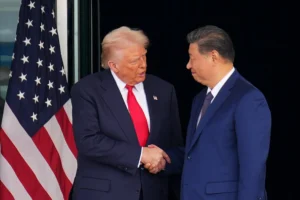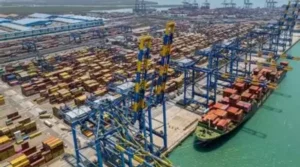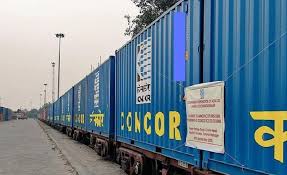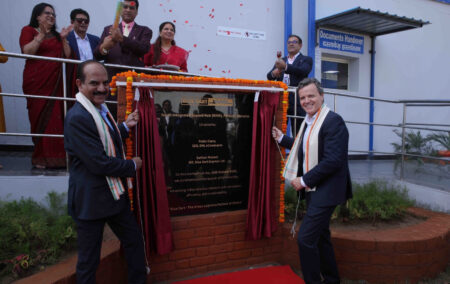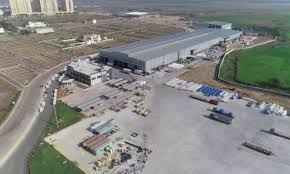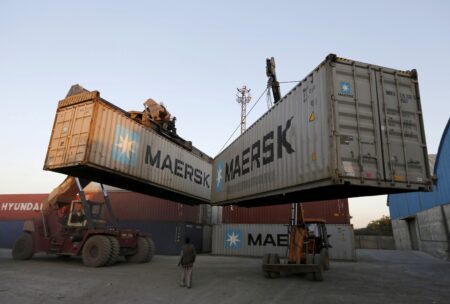In the 2024 Union Budget, the Indian government allocated ₹1,10,055 crore to enhance the logistics sector, aiming to reduce logistics costs and improve efficiency. This investment focused on infrastructure development, including the completion of national highways in states like Tamil Nadu, Assam, Kerala, and West Bengal, which was expected to significantly improve road connectivity. Additionally, the budget emphasised the commissioning of the Eastern and Western Dedicated Freight Corridors (DFCs), with a substantial allocation to expedite their completion, thereby reducing transit times and costs. A ₹1,500 crore scheme was introduced to promote digital payments, enhancing customer interfaces for logistics companies. Furthermore, a new scheme was launched to support the flagging of merchant ships in India, with a fund of ₹1,624 crore allocated to provide subsidy support to Indian ship owners. The budget also reflected a commitment to increasing green energy initiatives, aiming for a zero-carbon environment.
As we approach the 2025 Union Budget, industry stakeholders are keenly anticipating further support to sustain and accelerate this growth trajectory. The logistics sector is particularly hopeful for continued investments in multimodal connectivity, tax reforms, and policies that foster innovation and sustainability. The upcoming budget is expected to address these areas, ensuring that the logistics industry remains a cornerstone of India’s economic development.

As India aspires to grow as a developed economy by 2047, the focus should be on real Ease of Doing Business, simplifying laws, and fostering trust to boost sectors like manufacturing, healthcare, telecom, textiles, chemicals, and pharma. FFFAI suggests establishing a department dedicated to simplifying statutory clearances for export and import consignments.
Several key areas should be prioritised in the budget for the logistics sector:
- Setting timelines for customs clearance (24 hours for air imports, 48 hours for sea imports, etc.).
- Establishing escalation mechanisms for consignment delays.
- Simplifying bottlenecks in faceless assessments.
- Creating a trust-based environment with clear laws to prevent interpretative disputes.
- Emphasising mandatory training and skill development for all stakeholders.
- Adopting a consultative approach for voluntary customs duty payments to reduce litigation.
- Implementing next-generation software to replace the ICEGATE/EDI system.
These measures will reduce logistics costs, enhance global competitiveness, and create transparency in EXIM clearance processes.

For India’s logistics sector to flourish, the integration of physical and regulatory infrastructure is crucial. While physical infrastructure, such as ports, roads, and railways, is improving, the regulatory framework remains outdated and burdensome. Compliance challenges create stress for law-abiding businesses, often leading to unnecessary legal battles that drain time and resources, particularly for MSMEs, which have limited resources. This adversarial approach can hinder growth and innovation in the sector. To address this, the government should focus on building trust with businesses, simplifying compliance processes, updating outdated laws, and adopting a partnership-driven approach. A supportive regulatory framework is essential for unlocking the full potential of India’s logistics sector. Hopefully, the upcoming budget will address these issues to foster growth.

The upcoming budget is expected to prioritize capital expenditure in logistics infrastructure, particularly expanding off-airport warehousing. This will support the ‘Made in India’ initiative by creating modern infrastructure to handle increased exports and alleviate airport congestion. Developing technologically advanced logistics hubs at off-airport locations is key to boosting trade efficiency.
With space constraints at major airports and rising air cargo volumes, the budget may prioritize the creation of Air Freight Stations (AFS) across India. These facilities will allow customs clearance and cargo processing away from congested terminals, reducing logistics costs and aligning with the National Logistics Policy under PM Gati Shakti.
The budget may also focus on enhancing intermodal connectivity, with investments in multi-modal logistics parks that integrate highways, railways, ports, and airports. This will streamline goods movement, reduce transportation time, and improve supply chain efficiency.
To reduce logistics costs further, the budget could introduce GST rate rationalizations, expedited online GST refund processing, tax incentives for logistics service providers, and simplified regulatory compliance, making Indian logistics more globally competitive.
Sustainability will also be a priority, with incentives for electric and alternative fuel vehicles, sustainable warehousing infrastructure, and policies to reduce carbon emissions in transportation, aligning the logistics sector with national and global sustainability goals.
Finally, the budget is expected to emphasize skill development in the logistics sector, with initiatives for technical education and workforce upskilling to support India’s growing global logistics ambitions.

India is growing rapidly, with strong government support driving this growth. Senior bureaucrats have shown a willingness to assess industry needs and implement measures that benefit exports and the economy. For the upcoming budget, we hope for initiatives that strengthen the logistics sector, enhance infrastructure, and support exporters. The COVID-19 pandemic underscored the crucial role of logistics, with the industry working tirelessly to meet demands. Policies that recognise this resilience will fuel further progress. India is headed in the right direction, and more incentives and schemes for infrastructure development in logistics are needed.

For the upcoming Union Budget, the logistics sector expects measures that boost business efficiency through tech-driven, solution-oriented approaches. Building on the ₹11.11 lakh crore allocation for infrastructure in Budget 2024-25, there is hope for further steps to empower MSMEs, promote youth skilling, and develop investment-ready industrial parks. Increased infrastructure spending is vital to reducing logistics costs, unlocking economic corridors, and driving sustainable growth. The sector anticipates policy measures to address structural bottlenecks, prioritize renewable energy, and invest in technological innovation and human capital. With these initiatives, the logistics sector is set to play a key role in India’s goal of becoming a $7 trillion economy by 2030.

The Indian Budget 2025 presents an opportunity to boost the logistics sector’s transformation. Key priorities include increased allocation for digital infrastructure, incentives for homegrown software development, and support for logistics startups to enhance India’s tech leadership.
Funds should focus on multimodal logistics parks under PM Gati Shakti, simplifying warehouse clearances, and improving last-mile connectivity, especially in Tier 2 and 3 cities. Streamlined regulations, reduced corporate taxes for tech businesses, and efficient clearance mechanisms will improve ease of doing business.
Sustainability initiatives should include tax benefits for green logistics solutions, such as EV fleets and renewable energy warehouses, along with R&D support for sustainable practices.
GST simplification, fast-tracked customs clearances, and tech-driven solutions for documentation will enhance efficiency. Further, public-private skilling partnerships, support for SME tech upgrades, and credit incentives will drive growth.
Incentives for digitization in the freight sector, support for exporters, and a dedicated fund for AI in logistics will foster innovation and global competitiveness. These measures will position India as a leader in supply chain innovation.

As a key driver of India’s economic growth, the logistics industry anticipates The Union Budget 2025 to prioritize efficiency and innovation. Simplifying GST, accelerating multi-modal logistics parks, and incentivizing green logistics are essential to align with the National Logistics Policy.
While technology will continue to be the transformative power revolutionizing logistics operations and enhancing connectivity; it is equally important to focus on the training and skill development of aspiring professionals to remain competitive in the digital era.

Aligned with India’s goal of becoming a $7 trillion economy by 2030, Budget 2025 must focus on rapid infrastructure development to unlock the logistics and transportation sector’s full potential as a driver of economic progress.
The budget should reflect the government’s commitment to reforms, stable decision-making, and progressive policies. These can foster technological innovations, empower start-ups, and enhance the sector’s competitiveness and resilience.
The industry expects bold steps to improve last-mile connectivity, transformative reforms, and incentives for EV charging infrastructure to drive sustainability in logistics. Additionally, enhancing the ease of doing business through initiatives like ‘Jan Vishwas Bill 2.0,’ digitalisation, and increased Mudra loan limits would support MSME growth, a key economic driver.
By prioritising digital transformation, Budget 2025 can boost logistics sector efficiency, align it with global standards, and create a competitive, future-ready ecosystem.

In line with India’s goal of becoming a $7 trillion economy by 2030, the upcoming Budget 2025 presents a key opportunity to address challenges related to efficiency, sustainability, and global competitiveness. The logistics sector, at a transformative crossroads, stands to benefit significantly from the Union Budget 2025-26.
It is hoped that the government will prioritise investments in infrastructure modernisation, particularly in the development of smart logistics parks and multimodal transport networks that embrace sustainable practices. A strong emphasis on green logistics is expected, with incentives to encourage the use of electric vehicles, biofuels, and IoT-enabled transport systems. These measures are seen as essential for reducing logistics costs and carbon emissions, paving the way for a more sustainable future in the sector.
Furthermore, there is anticipation for policies that foster an equitable environment for all stakeholders, from large corporations to MSMEs, promoting inclusive growth across the logistics industry.

To achieve a $7 trillion economy by 2030, the logistics industry must be a key growth driver. The sector requires consistent policy, technology, and accelerated infrastructure reforms. The upcoming Budget should focus on continuity in decision-making and continued capex investment in transportation, port, and digital infrastructure, in line with the National Logistics Policy.
Alongside infrastructure and tax reforms, the industry needs strategic resource allocation to address challenges like fuel price fluctuations and supply chain disruptions. Investments in advanced technology and sustainability standards will position India as a global logistics leader. Incentives for green logistics, streamlining GST, and promoting eco-friendly practices like electric vehicles are essential.
Support for SMEs, start-ups, skill development, and public-private collaborations will foster growth and innovation. Additionally, leveraging AI to optimize customs, warehousing, and supply chains is critical. Simplifying tax structures and providing financial incentives will help businesses manage costs and drive the logistics sector’s role in India’s economic progress.
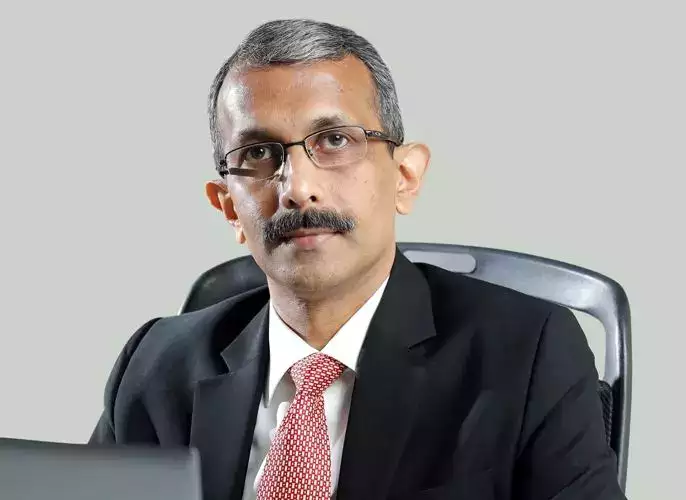
Integrating India into the global value chain and building a competitive logistics ecosystem are crucial for sustained economic growth and achieving the vision of Atmanirbhar Bharat. The logistics sector expects continued focus on capital expenditure for both physical and digital infrastructure, with a particular emphasis on port development to achieve a 10,000 MTPA capacity by 2047. Investments in transport connectivity, rail corridors, EV truck adoption incentives, and fiscal benefits for EV infrastructure will enhance sustainable multimodal connectivity.
To boost EXIM trade, the sector hopes for policies that leverage existing infrastructure around ports, such as allowing CFS-ICDs to handle air cargo and exempting certain services, like the storage and handling of containerized agri-products, from GST. Continued export promotion incentives and the development of export hubs will strengthen Indian manufacturing, make it globally competitive, and attract investments to boost exports.

As the Union Budget approaches, I believe it’s crucial for state governments to officially recognise logistics as an industry and logistics service providers as key players. Additionally, improving logistics efficiency through public-private partnerships is vital. While the government is developing infrastructure, private companies are focusing on non-infrastructure aspects. I would like to see more collaboration between the public and private sectors, which could significantly enhance progress.
India is known as the pharmacy of the world, and exports in this sector are expected to grow substantially. To further boost exports, I believe the government should focus on promoting the export of innovative drugs. This could help increase pharma exports from $30 billion to $60 billion, creating greater opportunities for India in the global pharmaceutical market.

The Indian government’s focus on enhancing shipping infrastructure and promoting indigenous shipbuilding has set the stage for transformative growth in the maritime sector. However, India’s current global market share in shipbuilding remains at a modest 0.05%, trailing far behind leaders like China (~47%), South Korea (~30%), and Japan (~17%). To bridge this gap, strategic government initiatives and enhanced budgetary support for ports and shipyards could serve as pivotal drivers of change, paving the way for a robust maritime economy.
The proposed Maritime Development Fund (MDF) for long-term indigenous manufacturing and the anticipated Shipbuilding Subsidy (SBS) Policy 2.0 are poised to strengthen the shipbuilding ecosystem, fostering self-reliance and global competitiveness. As the Union Budget 2025 approaches, prioritising investments in shipbuilding infrastructure, incentivizing green technologies, and creating export opportunities for Indian shipyards will be critical to ensuring sustained growth and positioning India as a global maritime player.

As the announcement of Budget 2025-26 approaches, it is crucial to address key areas in the logistics and transportation sector. Tax incentives should be provided for purchasing e-vehicles and establishing charging stations, alongside centralizing vehicle registration for transport vehicles (excluding passenger vehicles) to ease interstate movement. Disparities in state tax rates should be resolved to prevent transporters from registering vehicles in low-tax states unnecessarily. The cumbersome tax process for transferring vehicles between states must be abolished, with centralized compliance for transportation, warehousing, and allied services, supported by subsidies to encourage adherence. Budget allocation for skilling youth in logistics, offering educational loans, and incentivizing corporate and MSME investments in training programs is vital. MSMEs need simplified access to loans, transparent grants under Startup India, and seed funding. Technology adoption should be incentivized, and a national platform for logistics innovation created. Lastly, export subsidies for GI-tagged products and facilitation centers under the One District One Product initiative can empower MSMEs effectively.

Logistics will be a cornerstone in supporting India’s growth, especially as the nation aims for its Viksit Bharat vision by 2047. While India benefits from strong per capita consumption, challenges like significant wastage of perishable goods persist. Efficient logistics systems can bridge these gaps, enhancing the effectiveness of government policies. Globally, countries with advanced logistics systems set the benchmark, and India is quickly catching up. As logistics connects regions through e-commerce and FMCG networks, it reshapes consumption patterns, bringing goods closer to consumers.
Looking ahead, speed will become a defining factor for success in all sectors. The growing road congestion and rising demand for instant access make it essential for businesses to prioritise rapid execution, transportation, and service delivery. Companies that focus on speed will outpace competitors and contribute to India’s development, aligning perfectly with the Viksit Bharat Vision for a more connected and efficient future.

The upcoming Union Budget holds significant potential to drive India’s economic growth by addressing critical areas of logistics infrastructure. To strengthen the industrial base, it is hoped that the government will implement policies advancing the manufacturing, technology, and logistics sectors.
Continued investment in multimodal transport and inland waterways is seen as crucial for building resilient, efficient supply chains. As sustainability takes center stage, expectations are high for policies that promote green technologies, the integration of electric vehicles into commercial fleets, the use of alternative fuels, renewable energy infrastructure, and incentives for adopting sustainable practices. These initiatives could accelerate India’s journey to becoming a global manufacturing hub.
Additionally, there is anticipation for programs aimed at workforce development, including skill development initiatives and the expansion of training centers for logistics professionals. The budget represents a key opportunity to solidify India’s reputation as a strong economy that balances growth with inclusion, innovation, and sustainability.

The Union Budget has the potential to address critical issues in the logistics sector. Human resource development should be prioritized through training programs that equip the workforce with skills in technology, operations, and sustainability, along with initiatives to encourage female participation, especially in leadership and operational roles.
Recent disruptions in global supply chains have highlighted vulnerabilities, making it essential to diversify and strengthen risk management strategies. To foster economic growth, increased investments in logistics infrastructure and regulatory frameworks are needed to improve efficiency and unlock the full potential of regional and global trade.
The logistics industry is also facing mounting operational costs due to rising fuel prices, labor shortages, and fluctuating raw material costs. Addressing these challenges through tax relief and incentives for energy-efficient innovations will be vital.
Digitalization remains a key focus for the future of logistics. The integration of digital tools and systems can streamline operations, reduce costs, and enhance customer satisfaction, with government support playing a transformative role in this shift.
Finally, the success of the logistics sector depends on stronger collaboration between public and private sectors. By working together to enhance infrastructure, foster innovation, and streamline regulations, the logistics network can better support national competitiveness on the global stage.

Investments in the logistics sector are crucial for supporting India’s trade goals, improving economic efficiency, and helping MSMEs scale up. To strengthen India’s global position and meet the National Logistics Policy objectives, including the export target of US$2 trillion by 2030, the focus should be on simplifying export compliance procedures and reducing regulatory costs for logistics players. Measures to expedite e-commerce clearances and streamline cross-border online transactions are also needed.
Additionally, there should be increased budget allocation for the healthcare sector, which relies on a robust logistics network to efficiently deliver medical supplies and meet pharmaceutical and patient needs. Building on previous budget announcements, continued support for MSMEs, particularly in tier 2-3 cities, is essential. Empowering these businesses with capital and technology will enable them to compete effectively in global markets.

The transport and logistics industry requires ongoing government support to thrive. TDS exemptions should be reconsidered due to the sector’s low-margin nature (3-4%) and long payment cycles. While exemptions exist for owners with fewer than 10 vehicles, customers continue to deduct TDS out of compliance concerns. To promote EV adoption, faster depreciation for EV trucks is essential, along with fiscal incentives to develop EV fast-charging infrastructure on highways to reduce range anxiety and save drivers’ time. A comprehensive fiscal policy, in collaboration with the Ministry of Transport, is needed to promote LNG trucks, ensuring cleaner logistics and reduced costs. Additionally, the GST process must be made more transparent and faceless to improve efficiency.

The industrial explosives sector is crucial to India’s mining and infrastructure goals. For the Union Budget 2025, the sector hopes for significant investments in infrastructure projects, especially in railways, highways, and mining, which drive demand for explosives.
The rising cost of raw materials, particularly ammonium nitrate, remains a challenge. Rationalizing import duties or introducing tax incentives for key inputs would improve competitiveness.
In alignment with India’s sustainability goals, the government should promote eco-friendly explosives technologies through R&D incentives, supporting both environmental and operational efficiency.
Simplifying regulatory frameworks, especially around licensing and safety compliance, will enhance the business environment. With the right support, the industrial explosives sector can contribute significantly to India’s infrastructure growth and self-reliance vision.

While the Union Budget 2024 saw progress through initiatives like the PM Gati Shakti program and the National Logistics Policy, the logistics sector now looks to the Union Budget 2025 for further advancements. The sector expects a focus on emerging technologies like IoT, AI, automation, robotics, and 5G, supported by tax incentives and financial backing. Tech-driven infrastructure, such as smart logistics parks and IoT-enabled transport systems, will be key, with Public-Private Partnerships (PPP) accelerating development.
There is anticipation for the introduction of single-window clearance systems to streamline approvals and enhance cross-border trade. An increase in capital expenditure for green technologies, including hydrogen-powered vehicles and sustainable logistics parks, is expected to foster a greener ecosystem.
In response to global trade volatility, measures like interest equalization and duty remission on exports are anticipated to improve the competitiveness of Indian exports. Budget 2025 holds the potential to drive innovation, sustainability, and global competitiveness, positioning India as a future logistics hub.

Amid India’s cyclical economic slowdown, marked by declining consumption and reduced capital expenditure in manufacturing and infrastructure, the upcoming budget presents a critical opportunity to drive sustainable growth. It can empower MSMEs to adopt green practices such as renewable energy, waste reduction, and sustainable supply chains by addressing challenges like limited resources and awareness.
Key measures could include easier access to green financing, tax benefits for eco-friendly investments, and a robust Green Credit and Carbon Market framework to incentivize sustainability and offset emissions. Enhancing supply chain transparency can further promote responsible sourcing, reduce environmental impact, and build resilience, aligning with India’s Net Zero 2070 goals. Practical policies are essential to enable businesses to transition seamlessly toward a greener and more resilient future for India.

